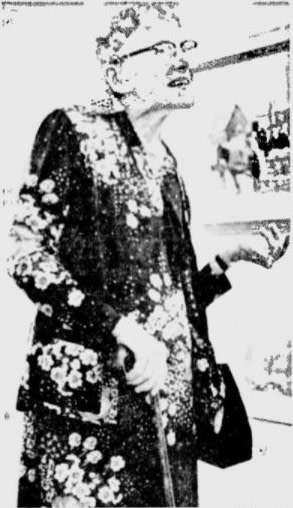Kathleen Moir Morris
Art and the artist. Inseparable yet separate, first one then apart, the most symbiotic of all relationships and the most mysterious. Looking at art provokes an irresistible curiosity to peer behind the curtain and catch the artist at work, surrounded by his muses, brush in hand. But what if these accompanying inspirations turned out to be demons and the process of creation a tortured struggle? Would we care? Would it change how we looked at the work of art? It may and it may not, but the tale of Kathleen Moir Morris falls somewhere between the two mythical scenarios, and is one of courage and perseverance in the face of adversity.
In this case, knowing the artist is a way of deepening one's appreciation of her art, and yet so little has been written about her. Her true legacy lies in her quiet canvases, paintings that are hard to find these days, for they rarely leave the hands of their collectors. Their value is as much emotional as economic, imbued as they are with the genius and spirit of the artist.

Kathleen Moir Morris (1893-1986), pictured above (The Gazette, June 16, 1976)
Kathleen Moir Morris (1893-1986) is best known as a member of Montreal's Beaver Hall Group, where she became part of a tightly knit community of women painters who chose art as their career, an audacious move in days when artistic pursuits were primarily a male occupation. She shared her dedication with, among others, Nora Collyer, Emily Coonan, Prudence Heward, Mabel Lockerby, Mabel May, Lilias Torrance Newton, Sarah Robertson, Anne Savage and Ethel Seath, studying with such great artists and teachers as William Brymner and Maurice Cullen.
Largely ignored by art historians, these women produced a magnificent body of work, as diverse as they were, and distinctly Canadian. They were contemporaries of the Group of Seven. However, unlike the Group of Seven, whose accomplishments are well documented, Morris and her colleagues faced numerous challenges that their male counterparts were spared. This is a topic unto itself, and already covered in Barbara Meadowcroft's timely book Painting Friends, The Beaver Hall Women Painters (Véhicule Press, 1999).
The story of Kathleen Morris is more than one of battling society's mores. She was born physically infirm, suffering from a congenital disorder of the nervous system. It affected her speech and movements, but rather than succumb to her handicap, she blossomed amid the love and encouragement of her family, and painted, to use a colloquialism, "her heart out." The story is not unusual in itself. Mexican painter, Frida Kahlo, dealt with her crippling accident and its after effects by transforming the experience into an eviscerating and brutally personal visual diary, while Toulouse-Lautrec dragged his shattered body into the underworld of Paris, seeking in the demi-monde both creative inspiration and spiritual oblivion. Morris's approach to her lot was one of acceptance rather than rebellion, and her nature, despite the physical limitations, took flight in the realm of art with all the ardour and joy of an unfettered being. She was the fourth child and only daughter of Eliza Howard Bell and Montague John Morris, and according to all who know the family, the apple of her mother's eye. Noticing her predilection for drawing, she arranged first for piano lessons as a way of helping Kathleen coordinate her movements. That unfaltering support of the entire Morris family was, without a doubt, a defining factor in the artist's career. Whether it was because of Morris's gentleness of spirit, or her evident talent, that support continued throughout her formative years with the Art Association of Montreal and on in her life.
She had an uncanny ability to touch people, leaving long-lasting impressions on all she met, whether they be buyers or friends. One of those to cross paths with her was Toller Cranston, the international figure skater and artist, born and raised on Montreal's West Island. The Cranston and Morris families summered in the same enclave of Marshall's Bay, near Arnprior, Ontario. "Whether or not it was true," he recalled, "I believed that Kathleen Morris, with her genetic and artistic struggles, sensed in me a kindred spirit. That gave me strength and inspiration. She paid attention to me, artist to artist, although my world was the antithesis of hers. Mine was mystical, dark, exotic, decorative, fantastic, and not of this world, while Kathleen's depicted rural life and the honesty of nature. Each of her paintings glowed in its sincerity."
What a marvelously encapsulated paean, reflecting both the artist and the person, and the interconnectedness between the two.
Although Morris painted mainly landscapes and city scenes, her works were executed with an intimacy that found its way into the brush stroke and the palette, evoking something kindred to a gentle touch.
Her dialogue with nature recalls another great Canadian female painter, Emily Carr, who shared with Morris an independence of spirit and an understanding of the animal world. Both spent long hours sketching outdoors, listening to the trees and the murmur of clouds, solitary yet never alone. But what a different picture they must have made! Carr, stocky and determined, forging into the woods in her caravan-cum-studio, and Morris, fragile and twisted, struggling with her brushes.
"I couldn't walk miles, so I would be taken out to paint in a sleigh where I would be dropped off," Morris recalled in a 1976 interview with Wini Rider of The Gazette. "The snow was so deep that the only place I could paint was in the tracks of the sleigh. I wore an old fur coat with an apron over it and a fur hat with earflaps. I was enough to frighten anything that came down the road." The occasion of the article was Morris's exhibition at Galerie Walter Klinkhoff, an experience that left both the public and the then-elderly artist deeply moved. Although she had been widely acclaimed during her career, at 82, Morris felt forgotten by the changing art world. The bucolic scenes she painted were by now snapshots of a bygone era - carriages with their blanket-clad horses replaced by buses, graceful church spires dwarfed by geometric high-rises. Any yet. Looking at Morris's paintings, once again gracing the walls of the same art gallery, one is taken by their simple beauty and quiet pictorial order. These are works of the highest caliber, executed with all the confidence and astuteness of a great painter, taking the viewer beyond their narrative content and into the realm of pure visuals.
The cities of Montreal, Quebec and Ottawa, as well as their regions, provided her with an endless source of inspiration, and she found in their quotidian rhythm a melody that guided her on her painterly explorations.
From the first, deeply textured, nervous strokes of her early works, to the gentle swoops of colour and line in her more recent landscapes, Morris exhibited a unique style that set her apart from her contemporaries.
Her art can be compared to the work of the Nabis, a group of mainly French painters active in the 1890s, whose works were influenced by Gauguin's expressive use of colour and rhythmic pattern. Like them, Morris translated her surroundings in an intuitive manner, guided by colour more than form, the latter at the service of the former. It is this uncommon, at the time, approach to landscape - the Group of Seven painters were fascinated by form as much as light - that makes Morris's works seem so fresh today. They resonate with courage, both personal and artistic, and place her in the same category as David Milne, whose own quiet introspection took him on a very different creative journey.
While Picasso was changing the shape of art across the ocean, in Morris's quiet canvases time stands still, frozen for a moment in the flutter of birds huddled on a snow-covered branch, and in the deep green of trees lining the horizon. "I love to paint animals," Morris used to say, "I think cows are just beautiful but they're awful to paint. They've got lumps and bumps." These very lumps become patches of white and black in her paintings, coalescing into the form of a cow only to, once again, turn into an abstract play of light and dark as we step away from the canvas.
Morris painted city scenes with the same reverence for both subject and the demands of her métier. Long strokes make for a grid of buildings, the edges fluid, overlapping the image as if wrapped in an invisible tremor that vibrates underneath the paint, forming the texture as it meanders across the canvas. She painted from sketches, in which she simplified the forms and applied colour in bold, thick patches. When translating the image to a much larger canvas, Morris thinned the paint and added more detail to the architectural elements, but ultimately her works remain fluid, as if still in the process of becoming.
Writing about her 1939 solo exhibition, critic Robert Ayre found this approach "dispirited." "I have the feeling that she stops too soon, that she doesn't push far enough into her pictures." Perhaps this very reticence is what makes Morris's paintings so endearing to the viewer. They hover on that edge between reality and the unseen, allowing the eye to complete the image, allowing the one looking into the picture, as it were, to see into the heart of the artist. Morris painted that way she was, unassuming and yet very present. Her subject matter reflected her kinship with her surroundings and an appreciation of the simple life. She also felt deeply for the animal world, voicing her concerns publicly, as when she wrote to the press protesting the annual seal hunt.
It is perhaps this combination of the emotional with the pictorial that makes the works of Kathleen Moir Morris so pleasing to the eye. That appeal has outlasted numerous art trends and continues to this day. There is a marvelous respite in looking at her paintings, a sensation rarely associated with contemporary, conceptual art that aims to provoke rather than please.
But the pendulum swings, and a new generation of artist, whether in reaction to the public or because of their own need for a form of expression other than abstract, is returning to the figurative. Young artists on both sides of the ocean are once again studying the human form, rediscovering in the joy of painting what is closest to us, ourselves and our world, a new artistic challenge. The mind is ceding to the spirit, as it were, in art as elsewhere.
For Kathleen Morris there was never a question of painting with anything other than her heart. Away from the proverbial "madding crowd," at once condemned to and enamoured of her closest surroundings, she painted her own path into art history, and into the heart of anyone who wants to peek behind the curtain.
Source: Kathleen Morris Retrospective Exhibition Catalogue, Galerie Walter Klinkhoff (2003).




